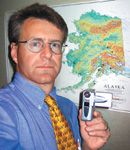Article
Pediatricians should take the lead in vision screening
Chicago—Screening to detect preclinical vision loss in children is important and should ideally be done in the offices of pediatricians or family practitioners. In addition, it is now time to add objective testing to pediatric practices, according to Robert W. Arnold, MD, who spoke at the annual meeting of the American Academy of Ophthalmology.

"Evidence-based medical studies published in 20041 indicate that vision screening is useful for children," according to Dr. Arnold. While cost is always an issue, the guidelines for vision screening used in the United States and issued by the American Academy of Pediatrics (AAP) would cost about $2.1 billion compared with $6 billion for those issued by the American Optometric Association.2
The Vision in Preschoolers (VIP) Study phase I looked at various mechanisms for screening. Results showed objective tests of acuity had a sensitivity of about 60%, the remote auto refractor was about 63%, and photoscreening was about 40%.3 However, in phase II of VIP Study using nurses and lay screeners, there was a decrease in sensitivity of LEA (designed by Lea Hyvarinen, MD) acuity testing methods.4
Other elements of the AAP guidelines that may be useful to pediatricians or family practitioners are the ocular history taking, ocular motility, and red reflex assessment.
In a prospective evaluation done after that of Donahue and colleagues, Dr. Arnold evaluated his own referrals from about mid-2002 to 2005 based on the indication for the examination, the results of the AAPOS gold-standard follow-up, and the age of the patient at referral. This evaluation was done at the same time as a community photoscreening program.2
An advocate of Bruckner testing
"The AAP guidelines recommend Bruckner testing, and in our area I have been advocating Bruckner testing since 1993. We also have Bruckner testing on our http://www.abcd-vision.org/ Web site. An enhanced version of the Bruckner test has a swinging flashlight test and eccentric vision past the direct ophthalmoscope through regular Bruckner testing. The AAP also advises pediatricians to question parents about whether their children have the appearance of strabismus. We used AAPOS gold-standard follow-up,"6 Dr. Arnold explained.
The investigators considered the three criteria for referral to a pediatric ophthalmologist: visual acuity, strabismus, or a positive Bruckner test, in association with the patient age at referral. They found a significant age-dependence to visual acuity referral pattern and the predictive value for visual acuity referrals was about 50%. The question of strabismus and a positive Bruckner test had about an 80% to 90% positive predictive value that was not age-dependent, Dr. Arnold reported.
"In addition, what matters a great deal to pediatricians is the time and the cost associated with screening. Time performing a Bruckner test is very short, whereas testing visual acuity as it is done currently takes more time," he said.
When visual acuity testing was compared with the ongoing community photoscreening program, the positive predictive value of the objective testing exceeded that of the acuity testing, Dr. Arnold said.
Newsletter
Don’t miss out—get Ophthalmology Times updates on the latest clinical advancements and expert interviews, straight to your inbox.





